
Mike Bailey’s enthusiasm for his work bubbles over when he takes down 3-D models from the shelves in his office — a model of the Willamette Valley color-coded by the different types of geology, the surface of Mars, a hemoglobin molecule, a human skull — all of them he created by entering 3-D data into a machine that manufactures the models.
But it wasn’t until his senior year as a mechanical engineering major when a class in computer graphics first gave him an inkling of his passion for 3-D images which he now applies to the field of scientific visualization.
“I can’t draw to save my life, so when I found out that I could actually make something look 3-D by writing a computer program — I was pretty excited,” he says.
Previously he had not considered graduate school, but that one class started him on a path that eventually led him to OSU. Bailey admits his route here was somewhat circuitous, but he followed the opportunities that were too good to pass up and where he thought he could make a difference.
“Everything I’ve done was pointing me towards Oregon State without me realizing that’s what it was doing — every job, every experience, every class I ever took or taught was pointing me to right here,” he says.
The unusual combination of mechanical engineering and computer graphics was just what Sandia National Labs was looking for when Bailey finished his Ph.D. at Purdue University. After just two years Purdue wanted him back as a professor and Bailey couldn’t pass up the chance to teach. But when an opportunity to work on the cutting-edge of computer graphics hardware came up Bailey moved to San Diego to be part of it. Then came what seemed to be a perfect job that combined his knowledge of government labs, industry, and teaching as the director of visualization at the San Diego Supercomputer Center and an adjunct professor at the University of California San Diego.
The only thing better was coming here to OSU, where he could collaborate with professors in a broad spectrum of departments including forestry, oceanography, geology, cognitive psychology, medicine and engineering using his 3-D graphics techniques to help them visualize and interact with their data.
“What I really like is working on real applications that benefit people. So if I can help the forestry department better understand their hill slope saturation data and they can then better understand how to prepare plants for a drought — then that has helped somebody,” he says.
Being at OSU has also allowed him to teach at many different levels from middle school outreach programs through graduate school. Bailey loves the whole spectrum of teaching — from getting pre-teen girls interested in computers at the OSU Saturday Academy to harnessing the “energy and enthusiasm” of 20-year-olds. And his skills have been recognized by 11 university teaching awards and two educational outreach awards.
He says the line between work and not-work is often indistinguishable to him. One time he recalls he could not find a time to meet with one of his colleagues in another department, but since she was at the Corvallis soccer fields coaching one Saturday and he was refereeing, they met between soccer games. “You just gotta love Corvallis for so many reasons,” he says.
In summary Bailey says, “I want this world to be a better place because I was here,” and so in everything he does — research, teaching, advising and even refereeing — that is his focus.

